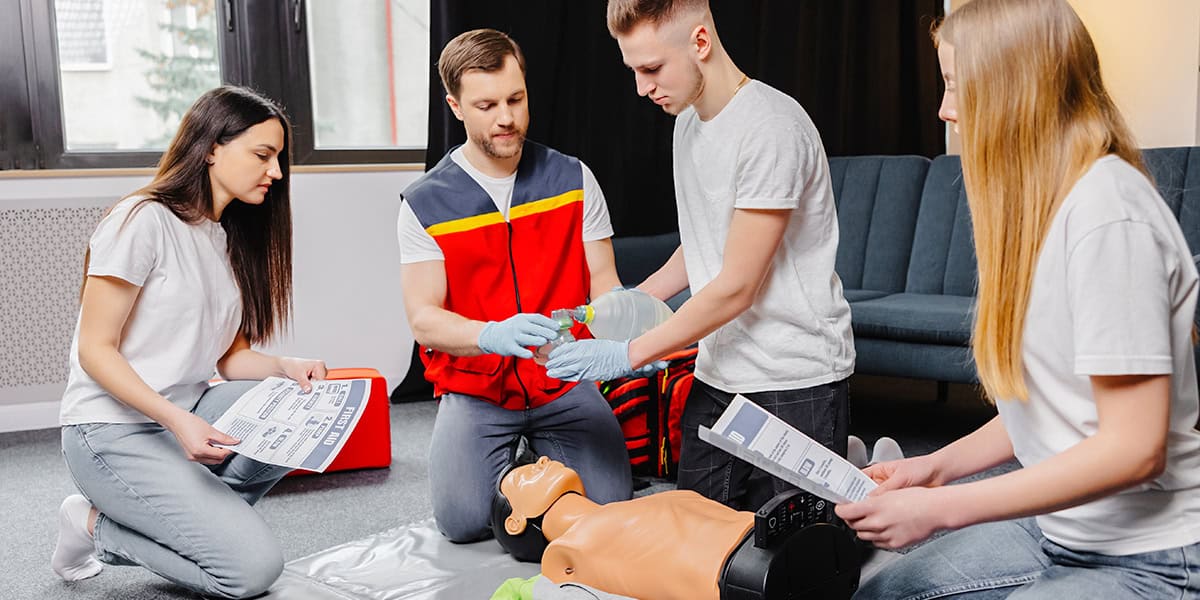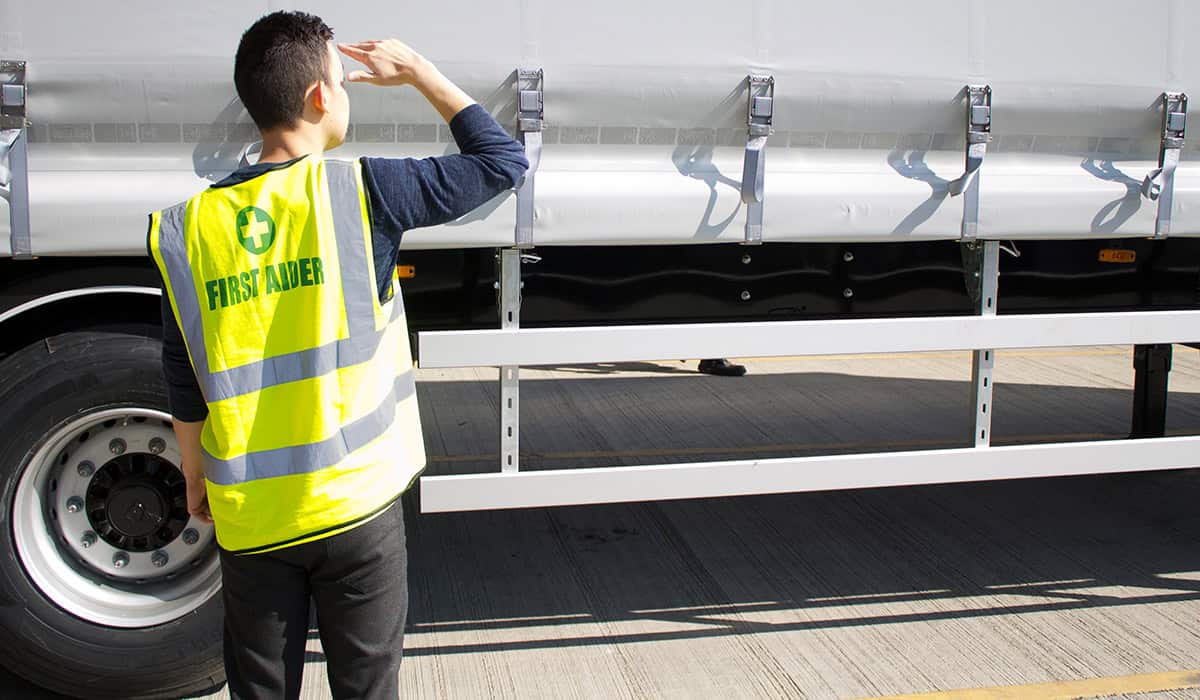
In an emergency situation, you will want to know exactly who to go to for help as quickly as possible, which is why most workplaces will have at least one designated first aider and fire marshal. It will waste time if you have to search for someone with the experience and training, especially if you have to find out who they are first, which is why it is so important to be informed on who the designated first aiders and where they can be found.
This article will help you understand what a first aider is and learn how to quickly identify first aiders in the workplace and other public settings.
What is a designated first aider?

A designated first aider is someone who has undergone training, usually an accredited three-day First Aid at Work (FAW) course, to ensure that they can provide basic care in various situations. They will also be in charge of keeping records of illnesses and injuries that happen on-site and managing the medical supplies that are available.
This person will need to have a valid certification to ensure that they are up to date on all of the changes in procedures and equipment and will know how to assess the casualty so that no further harm will come to them or anyone else. It is important to remember that the certification will expire three years after the first aider has taken the course. So, if you wish to keep the same first aider after three years, they will have to complete a requalification course.
In addition to needing to requalify every three years, the HSE recommend that the first aider attends refresher classes every year to remain abreast of any changes to how they should be handling the situation.
The amount of first aiders in a workplace will depend largely on a company’s risk assessment, if you feel that the site is a low risk it may be that a first aider isn’t required, in which case you will need to appoint someone who is unqualified to be in charge of the equipment and in the event of an emergency. However, the larger your workplace and the higher the risk level the more first aiders there should be.
For more information on the training that the designated first aider will need to undergo, read our blog: A Guide to First Aid Training.
How to identify first aiders in the workplace
There are several different ways that you will be able to tell who the first aiders are in the workplace. Some methods of identification will make it evident upon seeing the first aider who that person is, for example a lanyard or hi vis jacket, others, like first aid signs, will give you the first aider’s name and contact information just in case.Signage
Signs informing people of who the designated first aider is, are one of the most common ways to identify a workplace first aider. These can be hung near a piece of first aid equipment, for example an AED, to list who is trained to use it and how to contact them so that in an emergency it is easy to get help. Another common first aid sign is a first aid box sign which will be hung near the first aid kit identifying where it is and the first aider who is responsible for it.A method of identifying first aiders that is especially useful if you work in an office or somewhere with desks, is an A5 sign that will be able to sit on that person’s desk to inform everyone who their designated first aider is. These signs are extra useful in the event of an evacuation as the base can be removed and the sign can be transported with the first aider.
As with all first aid signs, those associated with first aiders have a green background and white symbol, either the general white cross or the appropriate symbol for the piece of equipment mentioned. For more information on signs in the workplace visit our blogs: A Guide to First Aid Signs and Symbols and Safety and First Aid Signs and Posters for the Workplace.

Hi vis jackets
Hi vis first aider jackets, similar to those used by fire marshals, are ideal for workplaces with low lighting or those where the first aider is likely to be on the move constantly. By wearing one of these jackets, it is likely that the first aider will stand out in a crowd making them easily recognisable.These vests are usually very distinctive given their reflective stripes and bold bright colours, the most well-known being a neon yellow or a mix of green and neon yellow. Although, the hi vis jackets are available in a variety of colours not just yellow and green. The title “First Aider” is written on the back of the jacket as well, some also including a black cross, to ensure that even if there are multiple people wearing hi vis, the first aider will stand out.
These jackets tend to be kept in a safe, dry place that is easily accessible in the event of an emergency or an evacuation so that the first aider can quickly put it on.
Armbands, lanyards and badges
Another way in which you can easily identify first-aiders in the workplace is through the use of items such as armbands, lanyards and badges. These won’t stand out as well as a sign or hi vis jacket, however, they will still have the intended effect of identifying the person to go to in an emergency. These forms of identification tend to be used in more low risk workplaces, for example offices and schools.First Aider Lanyards, for example, are very common in schools and offices as they will allow the first aider to carry around their work ID same as the other staff just with a lanyard that will ensure they are easy to differentiate. Lanyard might also be popular with first aiders who are required to carry around the key to the first aid cabinet with them while they work.
While the lanyards and badges are more subtle ways of identifying a first aider, the armbands can be made of reflective material similar to a hi vis, so that they will stand out a bit more in dim lighting. First aider armbands and badges are suited to first aiders who may have to put on additional layers when moving around the workplace because these will easily transfer to a different piece of clothing, for example a teacher monitoring the playground at lunch time will be able to attach them to their coat quickly.
Also, if your workplace requires the use of a helmet, a quick way of identifying the first aider on staff is to have a sticker that can be fixed to the front or back of the helmet. Generally first aiders on a construction site will also have a green helmet to make them easily identifiable, just as a fire marshal would have a red hard hat. So even if other forms of identification are hidden by PPE, or the person’s features are obscured, staff will be able to recognise the first aider by their helmet.
Which first aid identifiers are a legal requirement?

There is only one legal requirement for first aider identification in UK legislation, and that depends on whether the workplace has a first aid room or not. In the HSE’s 1981 Health and Safety (First-Aid) Regulations, it states that if your workplace were to have a first aid room then it must include a sign with a list of first aiders and their contact information.
Otherwise, there is no legal obligation for the workplace to have identification in place for anyone trained in first aid. However, it is advantageous to have at least one method available, so that in an emergency staff will be able to quickly identify who is best suited to help them and get the most efficient care possible.
For more information on the legal first aid requirements for a workplace, read our blog, What First Aid Requirements do Workplaces Need to Meet?.
For information on workplace first aid kits, read:
- A Guide to First Aid Stations
- What’s the Difference Between British Standard First Aid Kits vs HSE First Aid Kits?
- What First Aid Kit Do I Need for my Workplace?
Read our other blogs for more information on first aid or contact us for further advice and information on our products.
By Sarah Mason

